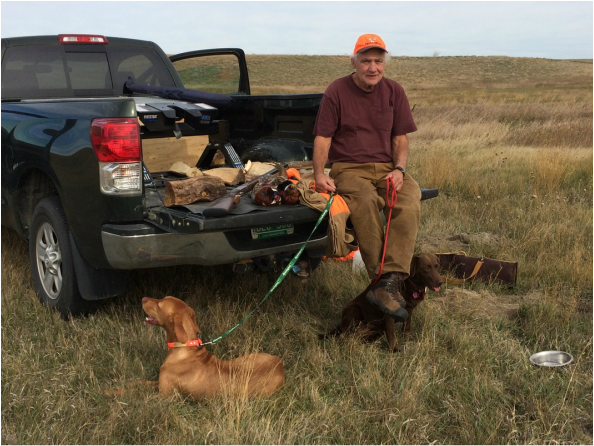There are plenty of birds here. According to the postal worker, this is one of the twenty-five best pheasant covers in the US. Today we saw a covey of 12 pheasants. A local hunter told us that the pheasants stay in the high country until it gets cold and then they group up and come down to the draws and coulees. Pheasants stroll in people’s yards as though they are chickens. One evening, peering through binoculars, we saw four pheasants in trees, like lords looking over the landscape.
The dogs are completely fagged out and limp around like abused slaves. We have started hunting them only once a day for fear of crippling them permanently. Sometimes we hunt without them in the afternoon and leave them sleeping on cushions behind the seats in the truck. They have claimed this space as their den. I think they suffer from anxiety that they will be left in this unfamiliar place.
Yesterday, we saw a dozen pronghorn antelope cross the dirt road in front of us. Two were bucks with horns. The lead one had the biggest rack and the last one with the supporting role, I suppose, sported a moderate rack.
We spent one evening after hunting in the Lutheran church basement, a domain familiar to Sally as a result of her Scandinavian upbringing in Wisconsin. We ate a home-cooked benefit dinner with the residents of Froid, Montana. Froid is French for cold. We sat with an elderly man and wife who filled us in on local history and weather. These folks were not demure and spoke to us right away in a loud and direct voice. They informed us that most of the people here are either Scandinavian or German descent.
We got permission to hunt on a 5,000 acre ranch near Plentywood, in the far northeast corner of Montana—a stone’s throw to both Saskatchewan and North Dakota. The ranch was homesteaded by our trailer park landlord’s grandfather in 1907. While standing on a bluff, it includes everything you can see to the horizon in almost all directions. Andrew’s dad is an artist and a hunter who has erected Tepees on the historical site of the stone circles that the native Indians (Sioux) left on a prominent hill. This is the home of Sitting Bull. The Indians wandered the plains seasonally and used the same family camps and the stones held down the bottom skins on their tepee. When the buffalo were gone, they were given canvas wall tents.
The mostly empty landscape is divided in to ‘block management’ sections. We have maps that show the general location of the blocks. We drive around the blocks looking for covers such as draws, creeks and fence lines that have tall grass, shrubs and rarely trees. Then we find the sign in box and give our self permission to hunt and get a detailed map. There are hundreds of block locations and we usually look for a stream running through the piece. The pheasants are generally in the narrow cover along the streams and the sharp-tail grouse and the Hungarian partridge can be in more open ground higher up.
It is sunny every day and the landscape is overall honey colored with dramatic shadows at the edges of the wide flat valleys, the evident result of water finding its way for eons. Sun glasses are mandatory when hunting this sun drenched terrain. This is the head waters of the Missouri river. North West Montana gets 13 inches of rain annually. We have seen two corn fields but the predominant crop is wheat.
The grain trucks are often double trailers and travel on the two lane blacktop at 70 mph. It is safest for a hunter to travel at this speed as the truckers are professionals intent on getting their produce to the grain elevators along the railroad. On the other hand, the speed people maintain in town is close to 15 mph. The posted limit in Medicine Lake is 8 mph. The towns are generally two to three streets deep and I suppose the people don’t want to get to the other side of town too quickly.
-Mike Burgess


 RSS Feed
RSS Feed